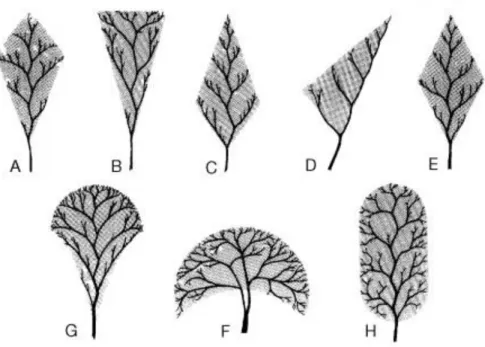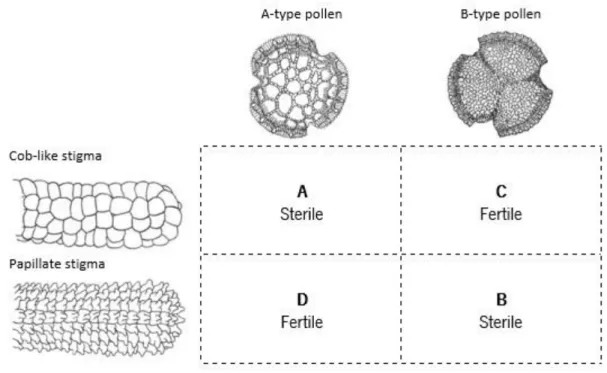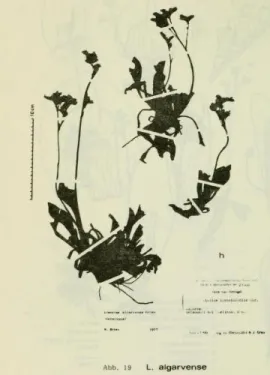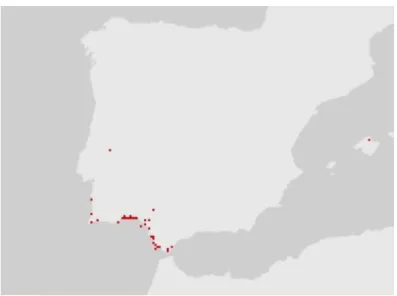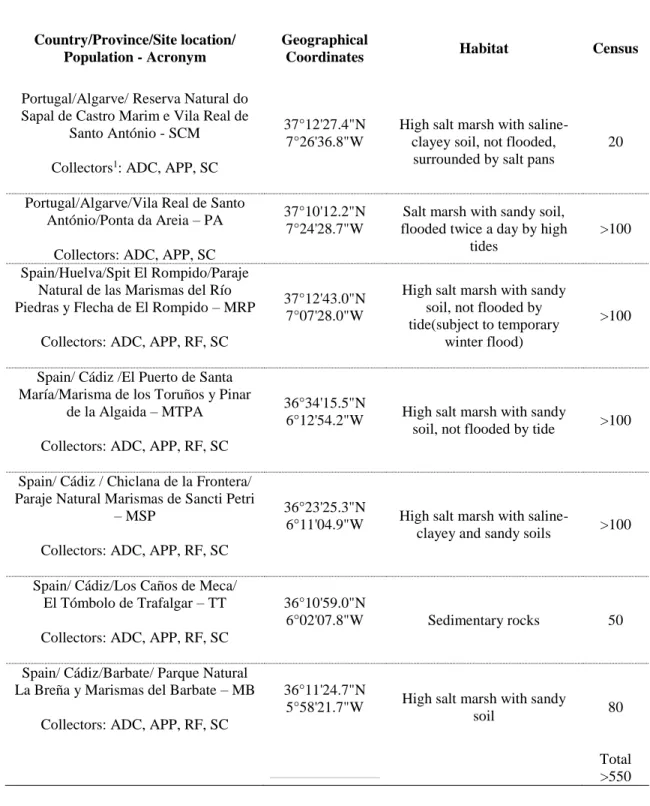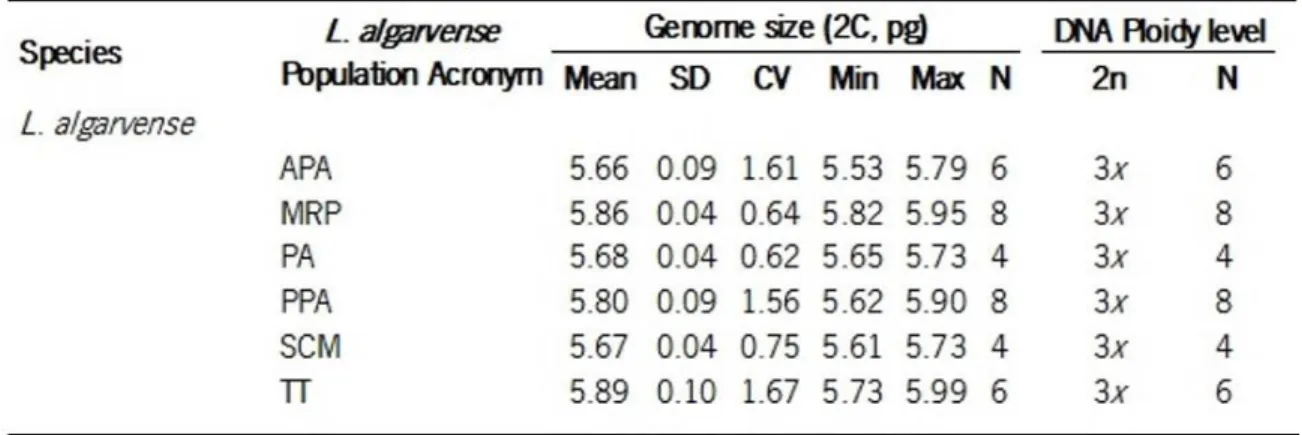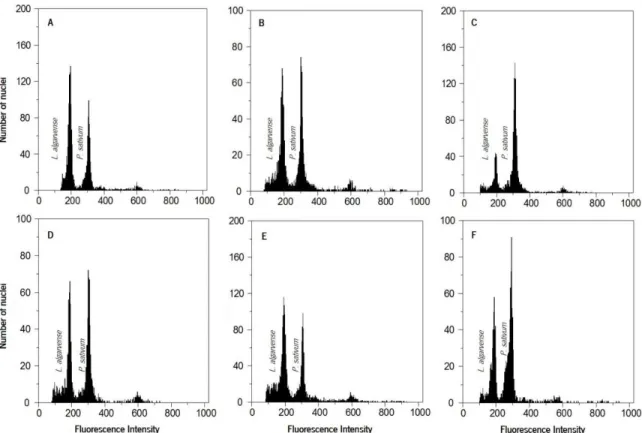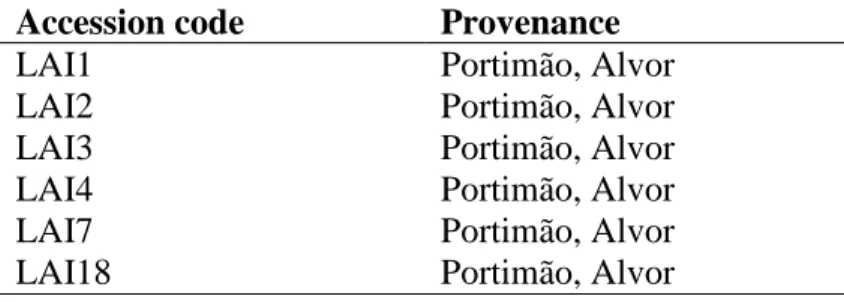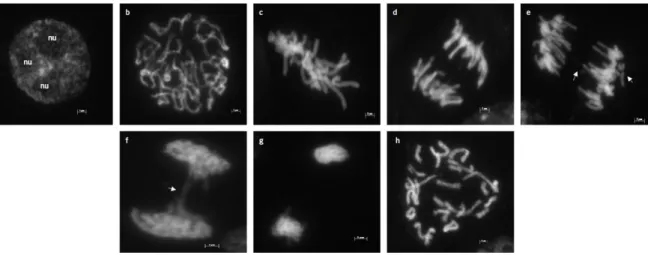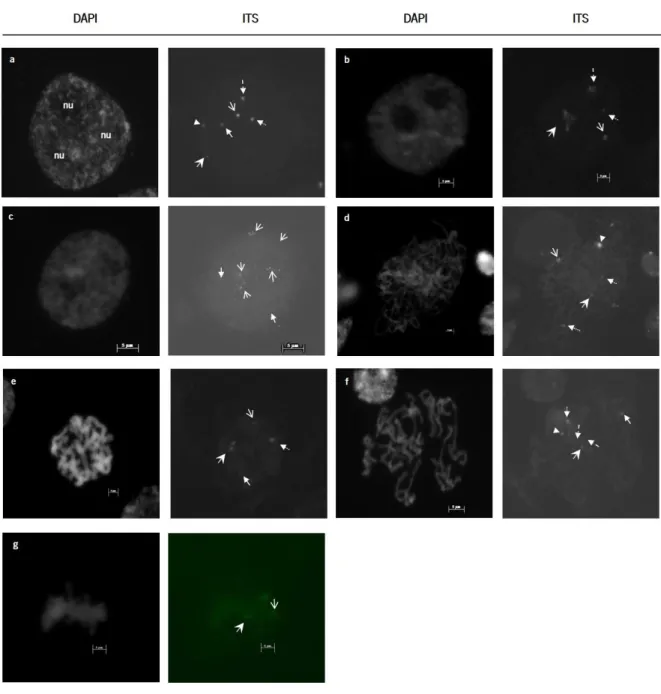Outubro 2015
Universidade do Minho
Escola de Ciências
Sofia Isabel Rodrigues da Conceição
Ex situ collection of Limonium spp.:
cytogenetic
and
reproductive
characterization for the conservation of
rare species
Tese de Mestrado
Biologia Molecular, Biotecnologia e
Bioempreendedorismo em Plantas
Trabalho efetuado sob orientação da
Investigadora Doutora Ana D. Caperta
e da
i
Acknowledgments
First of all, I want to thank to professor Ana Caperta for accepting to guide a student from a different university, for the patience and guidance provided and for always being available to help.
I want to thank also professor Teresa Lino-Neto for availability and for being always positive, and to all my colleagues in the genetic laboratory of Instituto Superior de Agronomia for the sympathy and shared knowledge.
Last but not least, I want to thank my family and friends for all the support during this last year.
ii
Abstract
Limonium algarvense isa halophyte species that grows in salthmarshes. There is a few knowledge about this species biology, specifically on cytogenetic variability and reproductive biology. This knowledge is fundamental to apply conservation methods since their habitat is being degraded by anthropic impacts.
The present study aims were to collect data regarding characterization of cytogenetic and male function of L. algarvense. Geographical and demography data confirmed that this species ranges from Southwest Portugal, in Algarve, to southern Spain. Flow cytometric studies in L. algarvense populations revealed that triploid cytotypes, indicating a cytotype consistency and homogeny across a geographical gradient. Cytogenetic analysis in distinct plants originated from different natural populations confirmed that L. algarvense presents 2n=3x=25 chromosomes, as previously reported. Exploratory studies using combined GISH and FISH analysis didn’t allow identifying the putative progenitors of L. algarvense. Finally, micro-sporogenesis and gametogenesis analyses showed several abnormalities during male gametes formation like presence of chromosomes bridges and laggard chromosomes during meiosis, the formation of restitution nuclei and cytomixis. These anomalies led to the formation of nonreduced pollen grains with different morphology which showed low viability and low germination rate.
The results present in this thesis provided useful data for a better understanding of this species reproductive biology which can contribute to design better strategies for this species conservation.
Key-Words: FISH, geographical distribution, GISH, karyotype, L. algarvense, meiotic
iii
Resumo
Limonium algarvense é uma espécie halófita que ocorre em sapais. A biologia desta
espécie é pouco conhecida, especificamente a sua biologia reprodutiva.Este tipo de conhecimento é fundamental para aplicar métodos de conservação, dado que o habitat desta espécie se encontra degradado devido a impactos de origem antrópica.
Os objetivos deste estudo foram recolher informação relativamente à caracterização citogenética e reprodutiva função masculina em L. algarvense. A informação geográfica e demográfica adquirida confirmaram que L. algarvense extende-se desde o sudoeste de Portugal, no Algarve, até ao sul de Espanha. Estudos de citometria de fluxo em populações de L. algarvense revelaram a presença de citotipos triploides, indicando uma consistência e homogeneidade de citotipos ao longo de um gradiente geográfico. Análises citogenéticas em diferentes plantas originárias de diferentes populações naturais confirmaram que que L.
algarvense apresenta 2n=3x=25 cromossomas, tal como relatado em estudos prévios.
Estudos exploratórios usando análises FISH e GISH combinadas não permitiram a identificação dos supostos progenitores de L. algarvense. L. algarvense. Finalmente, análises da micro-esporogénese e gametogénese mostraram várias anomalias durante a formação de gâmetas masculinos tais como a presença de pontes entre cromossomas e de cromossomas perdidos na placa equatorial durante a meiose, a formação de núcleos de restituição e citomixia. Estas anomalias originaram a formação de grãos de pólen não reduzidos com diferentes morfologias que apresentaram baixa viabilidade e taxa de germinação.
Os resultados apresentados nesta tese providenciam informação útil para um melhor conhecimento da biologia reprodutiva desta espécie, que pode contribuir para desenhar melhores estratégias de conservação desta espécie.
Palavras-chave: anomalias meióticas, cariotipo, distribuição geográfica, FISH, GISH, L.
iv
Table of Contents
Acknowledgments ... i
Abstract ... ii
Resumo... iii
List of Figures ... vii
List of Tables ... ix Abbreviations List ... x Literature Review ... 1 1.1 Plumbaginaceae ... 2 1.2 Limonium genus ... 2 1.3 Reproductive strategies ... 3
1.4 Taxonomical Complex Groups ... 5
1.5 Limonium species in the Portugal Coast ... 5
1.6 Conservation issues ... 6
1.7 Limonium algarvense Erben ... 7
1.8 Goals of this thesis ... 8
References ... 9
Chapter 1 - Geographical range, genome size, ploidy level characterization of L. algarvense populations and its communities ... 1
1.1 Introduction ... 2
1.2 Material and methods ... 3
1.2.1 Study species and study area ... 3
1.2.2 Plant growth conditions ... 3
v
1.3 Results ... 6
1.3.1 L. algarvense populations and communities characterization ... 6
1.3.2 Genome size and ploidy level analysis of L. algarvense throughout its geographic range ... 12
1.4 Discussion ... 14
1.5 References ... 16
Chapter 2 – Cytogenetic characterization of L. algarvense... 19
2.1 Introduction ... 20
2.2 Material and methods ... 22
2.2.1 Plant material collection and root fixation ... 22
2.2.2 DNA extraction and purification ... 22
2.2.3 Nick translation... 23
2.2.4 ITS probe amplification and labelling ... 23
2.2.5 Fluorescence in situ Hybridisation (FISH) And Genome in situ Hybridisation (GISH) ... 24
2.2.6 Fluorescence microscopy ... 25
2.3 Results ... 26
2.3.1 Mitotic cell division and karyotyping ... 26
2.3.2 FISH and GISH analysis ... 27
2.4 Discussion ... 30
2.5 References ... 31
Chapter 3- Meiotic abnormalities during gamete formation in triploid Limonium algarvense (Plumbaginaceae) ... 34
3.1 Introduction ... 35
vi
3.2.1 Plant Material ... 37
3.2.2 Cytological analysis of chromatin during meiosis and nuclear and cellular morphology characterization... 38
3.2.3 Callose detection ... 38
3.2.4 Flow cytometry ... 39
3.2.5 In vivo pollen viability ... 39
3.2.6 In vitro pollen germination ... 40
3.2.7 Statistical analysis ... 40
3.3 Results ... 40
3.3.1 Microsporogenesis characterization ... 40
3.3.2 Callose detection ... 47
3.3.3 In vitro pollen grain viability and pollen grain germination ... 47
3.4 Discussion ... 50
3.5 References ... 54
General Discussion and Future Prospects ... 59
vii
List of Figures
Figure 1. Several types of Limonium inflorescences (adapted from Erben, 1993). ... 3
Figure 2. Pollen stigma combinations in Limonium spp. (adapted from Baker 1966) ... 4
Figure 3. Dried specimen of L. algarvense Erben (adapted from Erben (1978)). ... 7
Figure 4. Actual L. algarvense distribution according to GBIF network (GBIF Secretariat: GBIF Backbone Taxonomy). ... 8
Figure 5. Histograms of fluorescence intensity from the nuclei isolated of L. algarvense individuals collected at different locations with the standard Pisum sativum 'Citrad' (2C= 9.09 pg DNA). ... 13
Figure 6. Distribution map of L. algarvense. Grey circles represent populations where
L. algarvense was sampled. ... 13
Figure 7. Dapi-stained interphase and c-mitotic plates of L. algarvense observed under a fluorescence microscope with a x100 objective. ... 26
Figure 8. ITS labelling in pre-meiotic interphase cells and meiocytes of L. algarvense under a fluorescence microscope with a x100 objective. ... 28
Figure 9. Combined Genomic in situ hybridization (GISH) and Flourescence in situ hybridization (FISH) in cells of L. algarvense in LAI18 under a fluorescence microscope with a x100 objective. ... 29
Figure 10. DAPI-stained male pre-meiotic and meiotic cells of L.algarvense observed under a fluorescence microscope with a x 100 objective. ... 42
Figure 11. Aceto-carmine staining of L. algarvense male meiocytes observed under a x100 objective. ... 44
Figure 12. L. algarvense pollen grain morphology, frequency and size. ... 45
Figure 13. Flow cytometric analysis in reproductive and somatic tissues of L. algarvense,
L. binervosum and L. ovalifolium. ... 46
Figure 14. Flow cytometry values of leaves and flower buds sections from L. algarvense,
L. ovalifolium and L. binervosum plants of the living collection. ... 46
Figure 15. Callose deposition along meiosis process in L. algarvense, L. ovalifolium and
viii
ix
List of Tables
Table 1. Locations, habitat and census of L.algarvense populations’ information. ... 5
Table 2. List of species found in L.algarvense communities. Voucher numbers are indicated for specimens deposited at herbarium LISI. Species that were only found in certain community are indicated with a black dot. ... 7
Table 3. Genome size estimates and ploidy level obtained in populations of L.
algarvense, sampled in Portugal and Spain. ... 12
Table 4. Accessions and provenance of Limonium plants used in this work. ... 22
Table 5. Accessions and provenance of Limonium plants studied in this work. ... 37
Table 6. Frequency (%) of meiotic abnormalities in L. algarvense plants of the living collection. ... 43
x
Abbreviations List
Bio Biotin bp base pair
BSA Bovine Serum Albumin DAPI 4’,6 -diamino-2-phenylindole
hydrochloride Dig Digoxigenin
DNA Deoxyribonucleic acid EB Enzyme buffer
EDTA Ethylenediamine tetraacetic acid FAA Formaldehyde- Acetic acid- ethanol FISH Fluorescence In situ Hybridization GISH Genome In Situ Hybridization ITS Internal Transcribed Spacer NORs Nuclear Organizer Regions PCR Polymerase Chain Reaction rDNA Ribosomal DNA
SDS Sodium Dodecyl Sulfate SSC Saline-Sodium Citrate h hour
Literature Review
1
Literature Review
2
1.1 Plumbaginaceae
Plumbaginaceae family is distributed across several parts of the world having
preferences for cold, arid, saline costal habitats and saline steppes (halophytes). Due to habitat preferences of species of this family a typical characteristic is the presence of stress-tolerant abilities due to the presence of scattered chalk glands in their foliage that exude water and calcium salts (Kubitzki, 1993). The glands are an adaptation to secrete excessive salt to the exterior of a plant (Flowers et al., 2010). Plumbaginaceae consists of 27 genera and have circa 650 species (Kubitzki, 1993). Two well differentiated subfamilies are Plumbaginoideae and Saticoideae. Plumbaginoideae comprises four genera, which are characterized by having a simple inflorescence, a raceme, spike or head (Kubitzki, 1993). The calyx is herbaceous and more or less glandular. The corolla is gamopetalous and the stamens are mostly free.
Staticoideae is significantly bigger in terms of genera having twenty-two genera. This
subfamily is characterized by having thyrsic inflorescences with cincinnate partial inflorescences, a scarious calyx, petals connate only at the base, filaments basally connate with the petals and styles mostly distinct from the base (Kubitzki, 1993). In this last subfamily the Limonium genus is included.
1.2 Limonium genus
Limonium Mill. genus is well distributed in coastal areas and saline steppes with a
great diversity in the Mediterranean region. According to Kubitzki, (1993) this genus comprise circa of 350 species while according to Erben, (1993) it comprises more than 400 species. The genus Limonium is roughly characterized by perennial and annual herbs or dwarf shrubs wherein the leaves are disposed in basal rosettes and the inflorescence is a panicle (Fig. 1) (Erben, 1993; Kubitzki, 1993). Different ploidy levels are found within this genus and typically the sexual species seem to be diploid (e.g L. ovalifolium; 2n=2x=16) and a few are tetraploid (e.g L. binervosum; 2n=4x=36) or hexaploid (e.g L. humile; 2n=6x=54). Also triploids and aneuploid tetraploids exist (Cowan et al., 1998).
Literature Review
3
Figure 1. Several types of Limonium inflorescences (adapted from Erben, 1993).
1.3 Reproductive strategies
One particularity of Limonium species is that there is a pollen/stigma dimorphism associated to a sporophytic self-incompatibility system (Fig. 2) (Baker, 1966). Four possible combinations are known: A- coarsely reticulate exine and cob-like stigmata; B- finely reticulate exine and papillate stigmata; C- finely reticulate exine and cob-like stigmata; D- coarsely reticulate exine and papillate stigmata. A and B represent self-incompatible combinations, while C and D are self-compatible combinations (Baker, 1966; Kubitzki, 1993). Because of this incompatibility system some species, specially polyploid ones, developed mechanisms to surpass this problem mainly by apomixis (agamospermy, asexual seed production) (Baker, 1966). A few examples of self-incompatible species Limonium spp. that are apomitic are L. binervosum, and L. dodartii (Baker, 1966). Also monomorphic populations like L. maritimum. However there are some species which have either the type A/”papillate” or type B/cob combinations which are self-fertile (Baker, 1966; Kubitzki, 1993). Examples of known monomorphic Limonium species, i.e. that exhibit only one flower morph, are: L. californicum, L. nashi var. trichogonum, L. humile. Baker, (1966) reported that these self-compatible monomorphic taxa are of recent origin as a result of recombination of the pollen and stigma characters from the dimorphic species.
Literature Review
4
Figure 2. Pollen stigma combinations in Limonium spp. (adapted from Baker 1966)
Studies in L. ovalifolium and L. multiflorum (2n=4x=32,35, 36), showed differences in these species reproductive strategies (Róis et al., 2012, 2015). L. ovalifolium species can either present self-incompatible A or B, with pollen grains with size varying from 40.43 µm to 45.65 µm and a high viability (~97%). Cytoembryological studies revealed that this species forms embryo sacs of sexual origin. These species has medium seed production and the germination can vary according to the population, ranging from 30% to 70%. In contrast, in
L. multiflorum there is not a specific pollen-stigma morphology since pollen grains exhibited
an abnormal exine pattern, but the pollen grains size ranged from 21.77 µm to 30.6 µm and had a very low viability (0-69%). L. multiflorum forms embryo sacs of apomictic origin only and produces more seeds than L. ovalifolium, having a germination rate of 70% to 80% (Róis
et al., 2015). This varied reproductive strategies lead huge intraspecific variety due to the
existence of the occurrence of hybridization and apomixis and for that reason it is difficult to classify Limonium spp. into distinct species (Ingrouille, 1984; Erben, 1993; Cowan et al., 1998; Ennos et al., 2005). For this situation these species form complex groups denominated taxonomically complex groups (TCGs), where the evolutionary processes within taxa are
Literature Review
5
taken into account instead of only the traditional taxonomic classification (Crandall et al., 2000; Ennos et al., 2005).
1.4 Taxonomical Complex Groups
An example of TCGs in Limonium is the one of L. vulgare- related species. Cortinhas
et al. (2015) realized a study using morphometric and flower morph data on the closely
morphologically related Limonium taxa: L.vulgare, L. humile and L. narbonense. This study reveals that the morphometric data allows better discrimination between species than morphological variables. Canonical discriminant analysis indicate that L. vulgare show higher morphological affinity with L. narbonense than L. humile. Also it was showed that the closest populations were not necessarily the most similar nor the furthest the most different indicating that there is no correlation between taximetry and geographic distribution. Furthermore, reproductive characters show differences between monomorphic populations and dimorphic populations. This study suggest that these species are relatively new and evolving. Also, in this study a new taxon in this TCG was described: Limonium
maritimum sp. nova.
Another example of TCGs in another distantly related genus is the Ranunculus
kuepferi complex. Similarly to Limonium, this complex presents distinct cytotypes such as
diploid, triploid, tetraploid, pentaploid and hexaploid (Cosendai and Hörandl, 2010). A study on this complex by Cosendai and Hörandl (2010) showed that triploid, pentaploid and hexaploid cytotypes were less stable than the other ones, predominantly appearing in sympatric zones with all the remaining cytotypes. According to these authors, their presence in sympatric zones is probably related with hybridization between diploid and tetraploid plants.
1.5 Limonium species in the Portugal Coast
In Portugal there are about 17 species of Limonium (Erben, 1993, 1978; Cortinhas et
al., 2015) such as Limonium algarvense Erben (Iberian-Mauritanian endemism), Limonium auriculae-ursifolium (Pourr.) Druce, L. binervosum, Limonium daveaui Erben (Lusitania
endemism), Limonium dodartii (Girard) Kuntze, Limonium echioides (L.) Mill., Limonium
lanceolatum (Hoffmanns. and Link) Franco (Iberian endemism), Limonium laxiusculum
Literature Review
6 multiflorum Erben (Lusitania endemism), Limonium narbonense, Limonium nydeggeri Erben
(Lusitania endemism), Limonium ovalifolium (Poir.) Kuntze, Limonium plurisquamatum Erben (Lusitania endemism), L. sinuatum (L.) Mill. , Limonium virgatum (Willd.) Fourr., and
Limonium vulgare Mill.. In the Madeira Island Limonium lowei R. Jardim, M. Seq., Capelo,
J.C. Costa and Rivas Mart. (endemic from Porto Santo Island, Madeira) (Jardim et al., 2007) and Limonium papillatum (Webb and Berthel.) Kuntze var. callibotryum Svent. (endemic from Ilhas Selvagens, Madeira) are also present (Hansen and Sunding, 1993). In the Azorean islands, L. vulgare is found (Borges et al., 2005).
1.6 Conservation issues
However some of these species face difficulties in relation to habitat fragmentation, due to the introduction of alien species that compete for space and resources, urbanization tourist activity, modifications on the water flow, dumping factory residues and abandon of traditional handling of salt pans (Gedan et al., 2009; Caperta et al., 2014). Given the situation of these species in Portugal, a conservation method that can be advantageous is in situ conservation. A complementary strategy is ex situ conservation in which a collection of seeds and/or living plants are created and can have different goals. There are some things to consider when it’s established an ex situ collection with the goal of habitat reintroduction, mainly from the genetic perspective. It’s necessary to have a large population collection, in order to maintain a maximum of genetic variation (Havens et al., 2006 ; Kramer and Havens, 2009). With these collections is possible to investigate diverse things like the species’ reproductive biology to allow for a better understanding for the creation of populations in
situ. Also, these collections can be used as an educational tool for the general public
clarifying aspects such as the human impact in the habitats and the importance of biodiversity (Havens et al., 2006).
An in situ conservation project already implemented and that appeared to have positive results is of L. multiflorum in Portugal (Caperta et al., 2013). L. multiflorum is endemic to Portugal that occurs in small populations, and faces habitat degradation. A study by Caperta et al. (2014) indicated that these species’ population decline due the increasing of urban development in the coastal areas and tourism impact. Nevertheless, this species appear to have low competition skills since it was noticed a negative correlation between L.
Literature Review
7 multiflorum and non-native vegetation. Furthermore, in L. multiflorum populations euploid
and aneuploid cytotypes occur (Róis et al., 2012). This genetic variability makes L.
multiflorum another strong example that for conservation not only ecological traits are
important (Caperta et al., 2014).
1.7 Limonium algarvense Erben
One species existing in Portugal that has few information regarding cytogenetic variability and reproductive biology, is Limonium algarvense. It was first described by Erben in 1978 (Fig. 3) as being a triploid species (2n=3x=25 chromosomes), resulting from the possible crossing of the diploid L. ovalifolium with the tetraploid L. binervosum (Erben, 1978, 1993; Ingrouille, 1985). It is part of the L. auriculae-ursifolium complex (aggregate) that also comprises the triploid L. auriculae-ursifolium sensu strictu and L. normannicum. Species of this complex distribute from the coasts of France (L. auriculae-ursifolium sensu
strictu and L. normannicum), in the Iberian Peninsula (L. algarvense) it ranges from Algarve
to the Coastal Lusitanian-Andalusian Province and is present in the Balearics Islands, and in Morocco coast. It is considered an Iberian-Mauritanian endemism (Erben, 1993; Fennane and Ibn-Tattou, 1999), although not yet represented in the GBIF network map (Fig. 4).
Literature Review
8
Figure 4. Actual L. algarvense distribution according to GBIF network (GBIF Secretariat: GBIF Backbone Taxonomy).
Additionally, a recent study from Rodrigues et al. (2015) unveiled the chemical profile testing in vitro antioxidant activity of methanol extracts, indicating that L. algarvense is a valued source of antioxidants especially the flowers, and moreover it has the presence of catechin, salicylic and rosmarinic acids that until now weren’t found in other tested Limonium species.
1.8 Goals of this thesis
The main scope of this thesis is to confirm data on L. algarvense distribution area, and characterize cytogenetic and reproductive variability of this species. To achieve this main goal, specific goals are:
i) To present distribution range, population size, genome size and ploidy levels of this species’ populations (Chapter 1);
ii) To determine its karyotype and to test the hybrid origin from this species using cytogenetic (Chapter 2);
iii) To elucidate its reproductive strategies by characterizing male reproductive function (Chapter 3).
Literature Review
9
References
Baker, H. G., (1966). The evolution, functioning and breakdown of heteromorphic incompatibility systems. I. The Plumbaginaceae, Evolution, 349–368.
Borges, P.A. V, Cunha, R., Gabriel, R., Martins, A.F., Silva, L., and Vieira, V. (2005). A list of the terrestrial fauna (Mollusca and Arthropoda) and flora (Bryophyta, Pteridophyta and Spermatophyta) from the Azores. Direcção Reg. do Ambient. Univ. dos Açores, Horta, Angra do Heroísmo Ponta Delgada 317.
Caperta, A. D., Espírito-Santo, M. D., Silva, V., Ferreira A., Paes, A. P., Róis, A. S., et al., (2014) Habitat specificity of a threatened and endemic, cliff-dwelling halophyte. AoB
Plants, 6,plu032.
Caperta, A. D., Paes, A. P., Espírito-Santo, M. D., (2013). Arribas da faixa costeira de Cascais: projeto de recuperaçao de habitats. El Botânico: Revista La AIMJB, 7, 69– 71.
Cortinhas, A., Erben, M., Paes, A. P., Espirito Santo, D., Guara-Requena, M., Caperta, A. D., (2015). Taxonomic complexity in the halophyte Limonium vulgare and related taxa (Plumbaginaceae): insights from analysis of morphological, reproductive and karyological data. Annals of Botany, 115, 369–383.
Cosendai, A. C., Hörandl, E., (2010). Cytotype stability, facultative apomixis and geographical parthenogenesis in Ranunculus kuepferi (Ranunculaceae). Annals of Botany, 105(3), 457–470.
Cowan, R., Ingrouille, M. J., & Lledó, M. D., (1998). The taxonomic treatment of agamosperms in the genus Limonium Mill. (Plumbaginaceae). Folia Geobotanica, 33(3), 353–366.
Crandall, K. A., Bininda-Emonds, O. R., Mace, G. M., Wayne, R. K., (2000). Considering evolutionary processes in conservation biology. Trends in Ecology & Evolution, 15(7), 290–295.
Literature Review
10
Ennos, R., French, A. G. C., Hollingsworth, P. M., (2005). Conserving taxonomic complexity. Trends Ecology & Evolution, 20(4), 164–8.
Erben, M., (1978). Die Gattung Limonium im südwestmediterranen Raum. Mitt Bot Staatssamml München, 14,361-626.
Erben, M., (1993). Limonium Mill. In: Castroviejo S, Aedo C, Cirujano S, Lainz M, Montserrat P, Morales R, Garmendia FM, Navarro C, Paiva J, Soriano C [eds.] Flora Iberica 3, 2-143, Real Jardín Botánico, CSIC, Madrid.
Fennane, M., Ibn-Tattou, M., (1999) Flore pratique du Maroc. Vol. 1. Pteridophyta, Gymnospermae, Angiospermae (Lauraceae-Neuradaceae), Inst. Scientifique.
Flowers, T. J., Galal, H. K., Bromham, L., (2010). Evolution of halophytes: multiple origins of salt tolerance in land plants. Functional Plant Biology, 37(7), 604–612.
GBIF Secretariat: GBIF Backbone Taxonomy, 2013-07-01. Accessed via http://www.gbif.org/species/4088484 on 2015-10-14
Gedan, K. B., Silliman, B. R., Bertness, M. D., (2009). Centuries of human-driven change in salt marsh ecosystems. Annual Review of Marine Science, 1, 117–141.
Hansen, A., Sunding, P., (1993) Flora of Macaronesia. Checklist of vascular plants, Vol.17, Sommerfeltia.
Havens, K., Vitt, P., Maunder, M., Guerrant, E. O., Dixon, K., (2006). Ex Situ Plant Conservation and Beyond. Bioscience, 56(6), 525-531
Ingrouille, M. J., (1984). A Taxometric Analysis of Limonium (Plumbaginaceae) in Western Europe. Plant Systematics and Evolution, 147(1-2), 103–118.
Ingrouille, M. J., (1985). The Limonium auriculae-ursifolium (Pourret) Druce group (Plumbaginaceae) in the Channel Isles. Watsonia, 15(3), 221–229.
Jardim, R., Sequeira, M. M. D., Capelo, J., Costa, J. C., (2007). Limonium lowei, um novo nome para o endemismo porto-santense Statice pyramidata Lowe (Plumbaginaceae). Silva Lusitana, 15(2), 277–278.
Literature Review
11
Kramer, A. T., Havens, K., (2009). Plant conservation genetics in a changing world. Trends in Plant Science, 14(11), 599–607.
Kubitzki, K., (1993). Plumbaginaceae, in: Kubitzki, K. Rohwer, J. Bittrich V. (Eds.), Flower. Plants Dicotyledons 62, Springer Berlin Heidelberg, 523–530.
Rodrigues, M. J., Soszynski, A., Martins, A., Rauter, A. P., Neng, N. R., Nogueira, J. M. F.,
et al., (2015). Unravelling the antioxidant potential and the phenolic composition of
different anatomical organs of the marine halophyte Limonium algarvense. Industrial Crops and Products, 77, 315–322.
Róis, A.S., Sádio, F., Paulo, O. S., Teixeira, G., Paes, A. P., Espírito-Santo, D., et al., (2015). Phylogeography and modes of reproduction in diploid and tetraploid halophytes of Limonium species (Plumbaginaceae): evidence for a pattern of geographical parthenogenesis, Annals of Botany, mcv138.
Róis, A.S., Teixeira, G., Sharbel, T. F., Fuchs, J., Martins, S., Espírito-Santo, D., et al., (2012). Male fertility versus sterility, cytotype, and DNA quantitative variation in seed production in diploid and tetraploid sea lavenders (Limonium sp., Plumbaginaceae) reveal diversity in reproduction modes. Sexual Plant Reproduction, 25(4), 305–318.
Chapter 1
1
Chapter 1 - Geographical range,
genomesize,
ploidy
level
characterization
of
L.
Chapter 1
2
1.1 Introduction
Plumbaginaceae family is commonly represented in saline environments
(halophytes) preferring saline steppes or coastal environments (Kubitzki, 1993). The genus
Limonium is composed by perennial and annuals species, characterized by a basal vegetative
rosette, a naked underground woody stem, floral stems (scapes) and a capsule with one seed ( Erben, 1978); Kubitzki, 1993) .
L. algarvense isa triploid species described by Erben in 1978 which makes part of the Boissier’s variety (Ingrouille, 1985). Considered an Iberian-Mauritanian endemism, its distribution ranges from Algarve to the Coastal Lusitanian-Andalusian Province, Balearics Islands and in Morocco (Erben, 1993; Fennane and Ibn-Tattou, 1999; Costa et al., 2014). This perennial rossulate chamaephyte grows in the welldrained upper tideland of sandy salt marshes that are only reached by sea water in high tides (Erben, 1993; Costa et al., 2014). The leaves are persistent, all basal, oblong-lanceolate or lanceolate with about 1.5-12 cm and have 3 to 5 parallel veins on the base. The inflorescence is of pyramidal type and has about 2 to 5 violet flowers. It flowers from March to October (Alcaraz, 1987) and its incompatibility morph is type B/”papillate” (Ingrouille, 1985).
The triploid cytotype is very common in Limonium spp. (Lledó et al., 2005). Other plant genera also have this characteristic such for example Ranunculus kuepferi (Ranunculaceae) which is reported to have cytotypes ranging from diploid to hexaploid (Cosendai and Hörandl, 2010). In this species the triploids exist in sympatric zones with diploids and tetraploids, and in some exceptions can establish triploid populations only (Burnier et al., 2009; Cosendai and Hörandl, 2010). Another example is from the genus
Miscanthus (Poaceae) in which in diploid and tetraploid sympatric zones, spontaneous triploids occurred (Nishiwaki et al., 2011). In both examples referred above the triploid cytotype is mainly predominant in sympatric zones between diploids and tetraploids and is thought to be a result of crossing between these distinct cytotypes. In addition, in both examples there is an indication that triploid cytotypes might be important in tetraploid populations’ maintenance.
Similarly to the given triploid examples, L. algarvense is described as a putative allopolyploid species and it is thought to be a hybrid between L. ovalifolium (diploid,
Chapter 1
3
2n=2x=16 chromosomes) and L. binervosum (tetraploid, 2n=4x=36 chromosomes), respectively (Cowan et al., 1998).
The objective of this chapter is to assemble data on present distribution range, population size, genome size and ploidy levels of L. algarvense species’ populations.
1.2 Material and methods
1.2.1 Study species and study area
Field surveys took part along Portuguese continental of Algarve shore and South of Spain in September 2014. L. algarvense specimens were collected from the following populations: Reserva Natural do Sapal de Castro Marim (SCM), Ponta da Areia (PA) both in Algarve; Paraje Natural de las Marismas del Río Piedras y Flecha de El Rompido (MRP), Marisma de los Toruños y Pinar de la Algaida (MTPA), Paraje Natural Marismas de Sancti Petri (MSP), El Tómbolo de Trafalgar (TT), Parque Natural La Breña y Marismas del Barbate (MB), all in Andalucia (Spain) (Table 1). Collected plants were herborized and deposited in João de Carvalho e Vasconcellos Herbarium (LISI) as described in Cortinhas et al., (2015). For each local seeds from several plants were also collected for establishment of experimental collections. Plants of the Portuguese populations Aljezur Praia da Amoreira (APA) and Portimão Alvor (PPA), previously collected and established in a greenhouse were also used.
1.2.2 Plant growth conditions
Collected seeds from all populations were placed in jiffy pots in a growth chamber (Rumed) with controlled light and temperature with a photoperiod of 18h light and 6 h dark at 25 ºC until germination. After 3 months, the plantlets were transplanted into pots with commercial substrate and grown in a greenhouse. Leaves from these plants were used for the flow cytometry analysis.
Chapter 1
4
1.2.3 Flow cytometry
For genome size and ploidy levels determination, flow cytometry analysis was performed using separately leaves from L. algarvense. Analysed plants were germinated from seeds collected from the respective populations. According to Galbraith et al., 1983 method, samples were chopped jointly with Pisum sativum ‘Ctirad’ (internal reference standard with 2C= 9.0 pg, (Doležel et al., 1998) in a Petri dish with 1 ml of WPB buffer (0.2 M Tris-HCl, 4mM Mg Cl2.6H2O, 1% Triton X-100, 2 mM EDTA Na2.2H2O, 86 mM NaCl, 10 mM metabisulphite, 1% PVP-10, pH adjusted to 7.5 and kept at 4ºC (Loureiro et al., 2007). The suspension was then filtered through a 50 µm mesh nylon filter and propidium iodide (50 µg/ml) and RNase (50 µg/ml) were addedto stain the DNA and prevent staining of double-stranded RNA, respectively. A Partec CyFlow Space flow cytometer (Partec GmbH, Görlitz, Germany) equipped with a green solid state laser (Cobolt Samba 532 nm, operating at 30 mW; Cobolt, Stockholm, Sweden) was used to measure the relative fluorescence of stained nuclei. Results were obtained using PARTEC FLOMAX software (v. 2.5). About 1300 nuclei per sample were analyzed.
Chapter 1
5
Table 1. Locations, habitat and census of L.algarvense populations’ information.
Country/Province/Site location/ Population - Acronym
Geographical
Coordinates Habitat Census
Portugal/Algarve/Reserva Natural do Sapal de Castro Marim e Vila Real de
Santo António - SCM Collectors1: ADC, APP, SC
37°12'27.4"N 7°26'36.8"W
High salt marsh with saline-clayey soil, not flooded,
surrounded by salt pans
20
Portugal/Algarve/Vila Real de Santo António/Ponta da Areia – PA
Collectors: ADC, APP, SC
37°10'12.2"N 7°24'28.7"W
Salt marsh with sandy soil, flooded twice a day by high
tides
>100 Spain/Huelva/Spit El Rompido/Paraje
Natural de las Marismas del Río Piedras y Flecha de El Rompido – MRP
Collectors: ADC, APP, RF, SC
37°12'43.0"N 7°07'28.0"W
High salt marsh with sandy soil, not flooded by tide(subject to temporary
winter flood)
>100
Spain/ Cádiz /El Puerto de Santa María/Marisma de los Toruños y Pinar
de la Algaida – MTPA Collectors: ADC, APP, RF, SC
36°34'15.5"N
6°12'54.2"W High salt marsh with sandy
soil, not flooded by tide >100 Spain/ Cádiz / Chiclana de la Frontera/
Paraje Natural Marismas de Sancti Petri – MSP
Collectors: ADC, APP, RF, SC
36°23'25.3"N
6°11'04.9"W High salt marsh with
saline-clayey and sandy soils >100 Spain/ Cádiz/Los Caños de Meca/
El Tómbolo de Trafalgar – TT Collectors: ADC, APP, RF, SC
36°10'59.0"N
6°02'07.8"W Sedimentary rocks 50 Spain/ Cádiz/Barbate/ Parque Natural
La Breña y Marismas del Barbate – MB Collectors: ADC, APP, RF, SC
36°11'24.7"N
5°58'21.7"W High salt marsh with sandy
soil 80
Total >550
1) Collectors: ADC – Ana D. Caperta; APP – Ana Paula Paes; RF – Rute Freitas, SC - Sofia Conceição from LEAF research unit, Instituto Superior de Agronomia, University of Lisbon.
Chapter 1
6
1.3 Results
1.3.1 L. algarvense populations and communities characterization
A total of seven L. algarvense populations which were at the end of flowering and beginning of fructification were analyzed. In general, the populations’ size (census) had between twenty and one hundred individuals, being the smallest population SCM with about twenty individuals. Generally, plants grew in high saltmarshes on sandy substrates flooded by tides or by seasonal floods in temporary winter floods. Exceptions were SCM, which grew on saline-clayed substrate, and TT that grew in sedimentary rocks. In some populations like PA, MB and MRP, L. algarvense species tend to grow under other species like Salsola
vermiculata, Suaeda vera and Limoniastrum monopetalum. This last species appeared in all
populations referred.
Regarding companion species present in L. algarvense communities, CMRP was the richest in variety presenting a total of seventy four species contrasting with MTPA which had only 1 companion species, which was Limonium virgatum (Table 2). In total, it was observed one hundred and seventy two different species, being the most well represented families Poaceae, Amaranthaceae, Plumbaginaceae, Apiaceae and Lamiaceae. Species like
Anthemis maritima, Arthrocnemum macrostachyum, Frankenia laevis, Halimione portulacoides, Inula crithmoides, Limoniastrum monopetalum, Sarcocornia fruticosa and Suaeda vera were present in several communities. Elymus elongatus, Limonium narbonense
and Spartina maritima only appeared in Portuguese communities while others like Cakile
maritima, Eurphobia paralias, Juniperus oxycedrus, Juniperus turbinata, Lotus creticus, Malcomia littorea and Polygonum maritimum only appeared in Spanish communities.
Chapter 1
7
Table 2. List of species found in L.algarvense communities. Voucher numbers are indicated for specimens deposited at herbarium
LISI. Species that were only found in certain community are indicated with a black dot.
Community (C) Companion Species Voucher
CSCM Anthemis maritima L.
Arthrocnemum macrostachyum (Moric.) Moris Elymus elongatus (Host) Runemark
Frankenia laevis L.
Halimione portulacoides (L.) All. Inula crithmoides L.
Juncus acutus L.
Limoniastrum monopetalum (L.) Boiss. Limonium algarvense Erben
Limonium lanceolatum (Hoffmanns. & Link) Franco 688/2014
Limonium narbonense Mill. ● 698/2014
Myriolimon diffusum (Pourr.) Lledó, Erben & M.B. Crespo Myriolimon ferulaceum (L.) Lledó, Erben & M.B. Crespo Polygonum equisetiforme Sm.
Salsola vermiculata L.
Sarcocornia fruticosa (L.) A.J. Scott Sarcocornia perennis (Mill.) A.J. Scott Spartina maritima (Curtis) Fernald ● Suaeda vera Forsskäl
CPA Anthemis maritima L.
Arthrocnemum macrostachyum (Moric.) Moris 706/2014
Elymus elongatus (Host) Runemark
Frankenia laevis L. 704/2014
Halimione portulacoides (L.) All. 707/2014
Inula crithmoides L.
Chapter 1
8
Continuation
CMSP Limoniastrum monopetalum (L.) Boiss. 724/2014
Halimione portulacoides (L.) All. 725/2014
Sarcocornia fruticosa (L.) A. J. Scott 723/2014
Suaeda vera Forsskäl 726/2014
CMTPA Limonium virgatum (Willd.) Fourr. ● 693/2014
CTT Ammophila arenaria (L.) Link subsp. arundinacea H. Lindb. 731/2014
Anthemis maritima L. 739/2014
Cakile maritima Scop. subsp. maritima 734/2014
Euphorbia paralias L. 740/2014
Halimium calycinum (L.) K. Koch ● 744/2014
Helichrysum italicum (Roth) G.Don. subsp. picardi (Boiss.&
Reut.) Franco ●
733/2014
Juniperus oxycedrus L. subsp. macrocarpa (Sm.) Ball 729/2014
Juniperus turbinata Guss. 732/2014
Limonium algarvense Erben 681/2014
Lobularia maritima (L.) Desf. Subsp. maritima ● 727/2014
Lotus creticus L. 743/2014
Malcolmia littorea (L.) R. Br. 736/2014
Medicago marina L. ● 742/2014
Ononis ramosissima Desf. ● 737/2014
Otanthus maritimus (L.) Hoffmanns. & Link ● 738/2014
Polygonum maritimum L. 741/2014
Senecio gallicus Vill. ● 728/2014
Silene niceensis All. ● 730/2014
Solanum nigrum L. ● 735/2014
CMRP Anagallis arvensis L. ●
Chapter 1
9
Continuation
Arthrocnemum macrostachyum (Moric.) Moris 714/2014
Cachrys libanotis L. ● Cakile maritima Scop.
Calystegia soldanella (L.) R. br. ● Carpobrotus edulis (L.) N. R. Br ● Centranthus calcitrapae (L.) Dufresne ● Cistanche phelypaea (L.) Coutinho ● Cistus crispus L. ● Cistus monspeliensis L. ● Crithmum maritimum L. ● Crucianella maritima L. ● Cytisus grandiflorus DC. ● Datura stramonium L. ● Daucus carota L. ●
Echium gaditanum Boiss. ● Echium plantagineum L. ● Eryngium maritimum L. ● Euphorbia paralias L. Euphorbia peplis L. ● Euphorbia terracina L. ● Foeniculum vulgare Miller ● Frankenia boissieri Reut. & Boiss. ●
Frankenia laevis L. 717/2014
Genista tournefortii Spach ●
Halimione portulacoides (L.) All. 718/2014
Holcus mollis L. ● Inula crithmoides L.
Chapter 1
10
Continuation
Juniperus oxycedrus L. subsp. macrocarpa (Sm.) Ball Juniperus turbinata Guss.
Juncus acutus L. Juncus bufonius L. ● Lagurus ovatus L. ●
Lavandula stoechas subsp. sampaiana Rozeira ●
Limoniastrum monopetalum (L.) Boiss. 715/2014
Limonium lanceolatum (Hoffmanns. & Link) Franco 686/2014
Lotus creticus L.
Malcolmia littorea (L.) R. Br. Marrubium vulgare L. ● Mentha suaveolens Enrh. ●
Mesembryanthemum nodiflorum L. ●
Myriolimon diffusum (Pourr.) Lledó, Erben & M.B. Crespo 722/2014
Myriolimon ferulaceum (L.) Lledó, Erben & M.B. Crespo 721/2014
Osyris lanceolata Hochst. & Stend. ● Oxalis pes-caprae L. ●
Pancratium maritimum L. ●
Parapholis filiformis (Roth) C.E. Hubbard ● Parapholis incurva (L.) C.E. Hubbard ● Paronychia argentea Lam. ●
Pistacia lentiscus L. ● Plantago coronopus L. ●
Polygonum equisetiforme Sm. 716/2014
Polygonum maritimum L.
Polypogon monspeliensis (L.) Desf. ● Pseudorlaya pumila (L.) Grande ●
Chapter 1 11 Continuation Rosmarinus officinalis L. ● Rubia peregrina L. ● Rumex bucephalophorus L. ● Sarcocornia fruticosa (L.) A.J. Scott Sarcocornia perennis (Mill.) A.J. Scott Salsola brevifolia Desf. ●
Salsola kali L. ●
Salsola vermiculata L. 720/2014
Silene gallica L. ● Silene nicaeensis All. ● Solanum sodomeum L. ●
Spergularia salina L. & C. Presl. ● Spartina densiflora Brongn ●
Suaeda vera Forsskäl 719/2014
Tamarix canariensis Willd. ● Thymus carnosus Boiss. ●
Chapter 1
12
1.3.2 Genome size and ploidy level analysis of L. algarvense throughout its
geographic range
Individuals from L. algarvense populations did not show any significant variation on genome size or in ploidy levels throughout the geographic range sampled from southwest Portugal to southern Spain. The genome size comprised between 5.89 pg and 5.66 pg, this later corresponding to the lowest value estimated. The registered minimum genome size value for a population was 5.53 and the maximum was 5.99. Regarding the ploidy level all individuals analyzed presented a triploid level (Table 3 and Fig. 5 and 6). Populations that are not represented in Table 3 were not analyzed due to leaves in bad conditions or plants showing not enough leaves.
Table 3. Genome size estimates and ploidy level obtained in populations of L. algarvense, sampled in Portugal and Spain.
The following data are given for each taxa, population and ploidy level: mean, standard deviation of the mean (SD), coefficient of variation (CV, %), minimum (Min) and maximum values (Max) of the holoploid genome size (2C, pg) followed by sample size for genome size estimates (N); DNA ploidy level (2n) and respective sample size (N) is also provided. DNA ploidy level: 3x, triploid.
Chapter 1
13
Figure 6. Distribution map of L. algarvense. Grey circles represent populations where L. algarvense was sampled. Figure 5. Histograms of fluorescence intensity from the nuclei isolated of L. algarvense individuals collected at different locations with the standard Pisum sativum 'Citrad' (2C= 9.09 pg DNA).
Chapter 1
14
1.4 Discussion
Field surveys allowed to unveil and increase data on L. algarvense distribution along the Portuguese and Spanish coast as well as increasing the number of circa 90 L. algarvense herbarium specimens as well as specimens of its communities at LISI collection. As reported from Erben (1993), it occurs in Algarve (Portugal), but later it was found in the Spanish coast and North Africa being now considered as an Iberian-Mauritanian endemism (Fennane and Ibn-Tattou, 1999). Our study confirm that at least it ranges from southwest Portugal, in Algarve in Praia da Amoreira (Aljezur) to Cabo Trafalgar (Cadiz) in southern Spain. In general, Spanish communities which include L. algarvense had more variety of species than Portuguese ones.
Previous study from Costa et al. (2014) provided data from communities where L.
algarvense was included. An association mentioned was Myriolimo diffusi-Limonietum algarvensis that occurred in welldrained soils inundated only during the highest tides, under
thermomediterranean dry bioclimate. Apart from Myrilimon diffusum, this association also includes Limoniastrum monopetalum and Suaeda vera. Its distribution area is restricted to the salt marshes of the Algarve. This correspond to our results where L. algarvense populations tend to grow in saltmarshes flooded by tides. In addition, Limoniastrum
monopetalum and Suaeda vera were similarly observed as a regular presence in several L. algarvense communities with this species growing under them. In Costa et al. (2014) study,
new data about a new alliance Limonion lanceolati-algarvensis was also reported, represented by chamaephytic communities that are reached by seawaters during the highest tide. This alliance is composed by diverse associations from west and southwest of the Iberian Peninsula such as Inulo crithmoidis-Myriolimetum ferulacei, Puccinellio
tenuifoliae-Limonietum plurisquamati, tenuifoliae-Limonietum lanceolati and Myriolimo diffusi-tenuifoliae-Limonietum algarvensis. This alliance has L. algarvense, L. daveaui, L. lanceolatum and Myriolimon diffusum as characteristic species.
In relation to genome size and ploidy levels estimates, flow cytometric results do not show differences in genome size or ploidy level along its distribution range, both in southwest of Portugal and in the south of Spain at Estreito Gibraltar west. Our results were in agreement with previous reports on its ploidy level Erben (1993) by chromosome counting. It can be
Chapter 1
15
hypothesized that there is a cytotype constancy and homogeneity across a geographical gradient which could be a result of genetic drift without sexual recombination (Cowan et al., 1998).
This cytotype constancy is observed in other genera like Taraxacum, Chondrilla and
Boechera that include triploid species (van Dijk, 2003; Kantama et al., 2007). A study of
apomitic triploids and diploids of Taraxacum and Chondrilla realized by van Dijk (2003) showed that in these genera, apomicts have a much extensive distribution than sexuals, but the distribution between the apomictic and diploids in large parts were the same. This differentiation in geographical distribution is called geographical parthenogenesis. It is also supposed that in sympatric zones, crosses between apomictic and sexual diploids can happen leading to the generation of new apomictic clones. However, according to these authors in the long term, those clones might be early extinct due to possible difficulties, like the increasing mutation loads and a failure at adaptation of environment changes. In particular, in Taraxacum, a population with high levels of clonal diversity was found (Van der Hulst et
al., 2000), indicating a dynamic equilibrium between newly formed clones from an areas and
Chapter 1
16
1.5 References
Alcaraz, J., (1987). Plumbaginaceae, in: Valdés,E. F Talavera,. B. Galiano, S. (Ed.), Flora Vasc. Andalucía Occident. 1, 1st ed., Ketres S.A., Barcelona, 295–308.
Burnier, J., Buerki, S., Arrigo, N., Küpfer, P., Alvarez, N., (2009). Genetic structure and evolution of Alpine polyploid complexes: Ranunculus kuepferi (Ranunculaceae) as a case study. Molecular Ecology, 18(17), 3730–3744
Cortinhas, A., Erben, M., Paes, A. P., Espirito Santo, D., Guara-Requena, M., Caperta, A. D., (2015). Taxonomic complexity in the halophyte Limonium vulgare and related taxa (Plumbaginaceae): insights from analysis of morphological, reproductive and karyological data. Annals of Botany, 115, 369–383.
Cosendai, A. C., Hörandl, E., (2010). Cytotype stability, facultative apomixis and geographical parthenogenesis in Ranunculus kuepferi (Ranunculaceae). Annals of Botany, 105(3), 457–470.
Costa, J. C., Neto, C., Monteiro-Henriques, T., Arsénio, P., Portela-Pereira E., Caperta, A.,
et al., (2014). Coastal halophilous Limonium communities from West Iberian
Peninsula. 1.
Cowan, R., Ingrouille, M. J., & Lledó, M. D., (1998). The taxonomic treatment of agamosperms in the genus Limonium Mill. (Plumbaginaceae). Folia Geobotanica, 33(3), 353–366.
van Dijk, P. J., (2003). Ecological and evolutionary opportunities of apomixis: insights from Taraxacum and Chondrilla. Philosophical Transactions of the Royal Society B: Biological Sciences, 358(1434), 1113–1121..
Doležel, J., Greilhuber, J., Lucretti, S., Meister, A., Lysák, M.A., Nardi, L., et al., (1998). Plant genome size estimation by flow cytometry: inter-laboratory comparison. Annals of Botany, 82, 17–26.
Erben, M., (1978). Die Gattung Limonium im südwestmediterranen Raum. Mitt Bot Staatssamml München, 14,361-626.
Chapter 1
17
Erben, M., (1993). Limonium Mill. In: Castroviejo S, Aedo C, Cirujano S, Lainz M, Montserrat P, Morales R, Garmendia FM, Navarro C, Paiva J, Soriano C [eds.] Flora Iberica 3, 2-143, Real Jardín Botánico, CSIC, Madrid.
Fennane, M., Ibn-Tattou, M., (1999) Flore pratique du Maroc. Vol. 1. Pteridophyta, Gymnospermae, Angiospermae (Lauraceae-Neuradaceae), Inst. Scientifique.
Galbraith, D. W., Harkins, K. R., Maddox, J. M., Ayres, N. M., Sharma, D. P., Firoozabady, E., (1983). Rapid Flow Cytometric Analysis of the Cell Cycle in Intact Plant Tissues. Science, 220(4601), 1049–1051.
Van der Hulst, R. G. M., Mes, T. H. M., Den Nijs, J. C. M., Bachmann, K., (2009). Amplified fragment length polymorphism (AFLP) markers reveal that population structure of triploid dandelions (Taraxacum officinale) exhibits both clonality and recombination. Molecular Ecology, 9(1), 1–8.
Ingrouille, M. J., (1985). The Limonium auriculae-ursifolium (Pourret) Druce group (Plumbaginaceae) in the Channel Isles. Watsonia, 15(3), 221–229.
Kantama, L., Sharbel, T. F., Schranz, M. E., Mitchell-Olds, T., de Vries, S., de Jong, H., (2007). Diploid apomicts of the Boechera holboellii complex display large-scale chromosome substitutions and aberrant chromosomes. Proceedings of the National Academy of Sciences, 104(35), 14026–14031.
Kubitzki, K., (1993). Plumbaginaceae, in: Kubitzki, K. Rohwer, J. Bittrich V. (Eds.), Flower. Plants Dicotyledons 62, Springer Berlin Heidelberg, 523–530.
Lledó, M. D., Crespo, M. B., Fay, M. F., Chase, M. W., (2005). Molecular phylogenetics of Limonium and related genera (Plumbaginaceae): biogeographical and systematic implications. American Journal of Botany, 92(7), 1189–1198.
Loureiro, J., Rodriguez, E., Doležel, J., Santos, C., (2007). Two new nuclear isolation buffers for plant DNA flow cytometry: a test with 37 species. Annals of Botany, 100(4), 875– 888.
Nishiwaki, A., Mizuguti, A., Kuwabara, S., Toma, Y., Ishigaki, G., Miyashita, T., et al., (2011). Discovery of natural Miscanthus (Poaceae) triploid plants in sympatric
Chapter 1
18
populations of Miscanthus sacchariflorus and Miscanthus sinensis in southern Japan. American Journal of Botany, 98(1), 154–159.
Chapter 2
19
Chapter 2 – Cytogenetic characterization
of L. algarvense
Chapter 2
20
2.1 Introduction
In angiosperms, polyploidy is a present contributor to their evolutionary path. Genome duplication play an vital role in this group leading to the huge diversification that is found nowadays (Soltis et al., 2009). Polyploidy is a two face coin, since it can have as benefits as disadvantages. Some of the advantages is that they can be efficient competitors comparing to diploids as gene doubling provides evolutionary success due heterosis that lead polyploids to be more vigorous, due to gene redundancy that minimizes the impact from the deleterious effect through dominant alleles and asexual reproduction (Comai, 2005). There are also some disadvantages as well, like problems in cell division leading to instable and aneuploid cells that tend to grow more slowly (Comai, 2005). In autopolyploid triploids, trivalents cannot be divided to form balanced products therefore leading to aneuploid gametes through chromosome random segregation (Comai, 2005). Aneuploidy occurrence is an important aspect not only because of its genomic instability due to unregular chromosome number, but also because it can trigger epigenetic changes (Papp et al., 1996; Birchler et al., 2005; Comai, 2005). Triploid species are frequently attained by unilateral sexual polyploidization where a haploid game fuses with a diploid one (De Storme and Mason, 2014). L. algarvense is hypothesized to be a triploid species being the result of the crossing between diploid Limonium ovalifolium and tetraploid Limonium binervosum (Ingrouille, 1985). Therefore, it is important to confirm its parental origin since both species occur in continental Portugal (Róis et al., 2015).
Fluorescence In situ Hybridization (FISH) allows to perform gene mapping, karyotype analysis and studies of phylogenetic relationships (Lim et al., 2007; Chester et al., 2010). On the other hand, Genome In Situ Hybridization (GISH) technique utilizes whole genome to discovery the nature of the hybrids genomes, like parental origin, being an important tool in polyploids studies (Lim et al., 2007; Chester et al., 2010). For example the internal transcribed spacer (ITS) region of the 18S-5.8S-26S nuclear ribosomal cistron is used as a nuclear marker in FISH studies as well as a nuclear phylogenetic marker. It enables the determination of position homology of nucleotide sites due to its length, is conserved at evolutionary level, and at the same time, some restriction sites generally occur inside it (Baldwing, 1992). There are many reasons why the used of ITS is advantageous. It is biparentally inherited, as it resides in the nuclear genome (Baldwing, 1992; Álvarez and
Chapter 2
21
Wendel, 2003) and there are a set of primers capable to amplifying this region for most plants, not needing to design primers each time it is used in different plant models (White et al., 1990; Álvarez and Wendel, 2003). There are a lot of small tandemly organized repeats about 10 kb, that can be in one or more chromosomal loci per haploid complement (Baldwing, 1992; Álvarez and Wendel, 2003). However, the use of ITS has some disadvantages like reduced species-level variability in recently diverged taxa, divergent paralogues and secondary structure problems (Baldwing, 1992; Álvarez and Wendel, 2003; Kress et al., 2005).
Combined FISH and GISH studies can be used to clarify if increases in chromosome number occurs through allopolyploidy phenomenon or autopolyploidy phenomenon (Chester
et al., 2010). Furthermore, utilization of high-copy repeat families such as ribosomal DNA
can be useful to find dispersion patterns on the genome and find chromosomal changes between species from the same genus ( Macas et al., 2007; Chester et al., 2010), since the rDNA loci from each parent can suffer autonomous evolutionary paths (O’Kane Jr et al., 1996; Hasterok et al., 2006). For example Fredotović et al. (2014) used a combination of FISH and GISH techniques to unveil the triparental origin of an onion Allium x cornutum using 5S and 35S rDNA probes in the hybrid. This study allowed to map 35S and 5S ribosomal genes regarding chromosomal position. Another example where FISH and GISH techniques were successfully applied on of natural apomicts of Boechera holboelli (Kantama, 2005; Kantama et al., 2007). Chromosome analyses based on DAPI fluorescence and FISH revealed the difference between the karyotypes of the diploid sexuals and the aneuploidy apomictic accessions. Furthermore, using total genomic DNA of B. stricta alone, or in combination with DNA of B. holboellii as probes allowed distinction between the stricta and
holboellii chromosomes in the B. × divaricarpa hybrid. Moreover, these studies also revealed
that the apomictic accessions are composed of different chromosome numbers originated from the stricta and holboellii parental species.
In the study here presented FISH and GISH techniques were used in order to identify chromosome polymorphisms and to investigate the genome origin of L. algarvense.
Chapter 2
22
2.2 Material and methods
2.2.1 Plant material collection and root fixation
Six plants obtained by seeds from Portimão, Alvor population growing in the greenhouse were used (Table 4). Some L. algarvense young root’s white tips were collected and fixed in ice and other in 2 mM 8-hydroxyquinoline to induce c- metaphases, according to protocol in Róis et al. (2012). Some of the fixed samples stored in ice for 24 h at 4ºC were then changed to a fresh ethanol: glacial acetic acid (3:1, v/v) solution for 1 h in agitation, renewed and kept 24 h in agitation. Samples placed in 8-hydroxyquinoline were kept 2 h at 4 ºC in the dark at room temperature. Both fixed materials were stored in -20ºC. Root tips were then digested with a 2% cellulase (Sigma), 2% cellulase ‘Onozuka R-10’ (Serva) and 2% pectinase (Sigma) (Caperta et al., 2002) in 1xEB [40 ml 0.1M citric acid-1-hydrate and 60 ml of 0.1 M sodium citrate dehydrate; pH 4.8 ( 1:10 dilution)] at 37ºC for 3 h (Caperta et
al., 2008). After that, squashes were made in a 45 % (v/v) acetic acid solution. Preparations
were fixed with CO2 and then, stained with 9 µl of 4’,6 -diamino-2-phenylindole hydrochloride (DAPI) (1mg/ml) mounted in Vectashield (Vector Laboratories).
Table 4. Accessions and provenance of Limonium plants used in this work.
Accession code Provenance
LAI1 Portimão, Alvor
LAI2 Portimão, Alvor
LAI3 Portimão, Alvor
LAI4 Portimão, Alvor
LAI7 Portimão, Alvor
LAI18 Portimão, Alvor
2.2.2 DNA extraction and purification
DNA from triploid L. algarvense, diploid L. ovalifolium, and tetraploid L.
binervosum, were extracted using a DNA extraction kit (Citogene), according to
manufacter’s instructions with some modifications. Young leaves from the respective plants kept in the greenhouse experimental collections were frozen with liquid nitrogen and macerated. Then, the tissue was placed in a 1.5 ml tube with 300 µl of Cell lysis, vortexed at
Chapter 2
23
high speed and incubated at 65ºC for 1 h with moderate agitation. After, 2 µl of RNase was added and the sample was incubated at 37ºC for 15 min and afterwards, it was cooled to room temperature and 100 µl of Protein precipitation was added mixing by vortexing on a vortex (Heidolph REAX 2000). The solution was then centrifuged at 13.000-16.000 x g for 10 min until the appearance of the pellet. Then the supernatant was transferred to a clean 1.5 ml tube with 300 µl 100% isopropanol and centrifuged again at 13.000 – 16.000 x g for 1 min. The supernatant was poured off, and 300 µl of 70% Ethanol was added. The pellet was washed and centrifuged again for 1 min, the supernatant was collected and the pellet was dried for around 30 min. Then, 50 µl of DNA hydration solution was added. Finally, each sample stayed overnight at room temperature and then it was stored at -20 ºC.
2.2.3 Nick translation
For genome labelling, DNA extracted at 2.2.2 was labelled with digoxiginin-11-dUTP or biotin-16-digoxiginin-11-dUTP using 4 µl of dNTP’s Mix, 4 µl of Nick Translation mix (Roche) and 12 µl of 1 µg DNA template (L. binervosum total genomic DNA or L. ovalifolium total genomic DNA) with distilled H2O. The mixture was incubated at 15º C for 90 min, and then
to stop the reaction 5 µl of 0.1M EDTA (pH 8.0) was added. Finally, this mixture was heated at 65ºC during 10 min.
2.2.4 ITS probe amplification and labelling
The ITS region was amplified by primers ITS-1 (5’ GTTTCCGTAGGTGAACCTGC3’) and ITS-4 (5’TCCTCCGCTTATTGATATGC3’). PCR amplification and labelling was carried in a 50 µl reaction containing 50-100 ng of DNA template ,10 x NH4 buffer ( Bioline), 1.5mM of MgCl2 (Bioline), 200 µM of dNTPs (Bioline),
0.5 µM of each primer, BSA, 5U/µl of Taq polymerase and 1µl of the fluorochrome Biotin (Bio) or Digoxigenin (DIG). The mixture was subjected to a polymerase chain reaction (PCR) with the following program: 94º for 3 min, 94º for 30 sec, 59º for 30 sec, 72º for 45 sec, 29 cycles at 94º for 30 sec and 72º for 6 min in a thermocycler (Bio-Rad DNA Engine Peltier thermal cycler).
Chapter 2
24
2.2.5 Fluorescence in situ Hybridisation (FISH) And Genome in situ
Hybridisation (GISH)
The Fluorescence In Situ Hybridization (FISH) technique allowed to detect a specific DNA sequence in intact cells at various life stages. It’s used a complementary prove labelled with a fluorescence marker that hybridise with the similar sequence at the target cell (Lim et
al., 2007; Chester et al., 2010). FISH was performed using a two days protocol described in
Caperta et al. (2008). FISH and GISH analyses were performed in preparations of pre-meiotic interphase cells, meiocytes and tapettum cells from three L. algarvense individuals, LAI1, LAI2 and LAI18.
In the first day, the preparations were subject to serial washes with ethanol: glacial acetic acid (3:1, v/v) solution rinsed in distilled water and with 2xSSC [Stock solution dilution from 20xSSC (3M NaCl, 0.32 M sodium citrate)]. Then the slides were put in a wet chamber for 10 min at 37 ºC with pepsine [Stock solution: 500 µg/ml in 0.01 M HCl ( use a 1/75 dilution in 0.01 M HCL). After that, 100 µl of Rnase [Stock solution - 10 mg/ml in 10 mM Tris.HCl, pH 8, prepared from ribonuclease A, in 10 mM Tris.HCl, pH 8 and 50% glycerol (use 100mg/ml diluted 1/100 in 2xSSC)] was applied for 1 h at 37ºC in a humid chamber. Then, the slides were dehydrated through an ethanol series and air dried. The stringency of the hybridization mixture used was 76%, obtained by 50% formamide, and 0,1xSSC. The hybridization mixture applied to each slide contained 50% formamide, 20xSSC, 12,5% SDS (w/v), 5 µg/µl of salmon sperm DNA, DNA probe previously labelled with a fluochrome (the quantity applied varied and with a concentration of 330 ng/µl), 50 % (w/v) dextran sulphate and distilled water which was denatured at 95 ºC for 10 min, and then ice cold for 5 min. The slides covered with a plastic lamella were placed in in a thermocycler (Bio-Rad DNA Engine Peltier thermal cycler) using the following program: 78 ºC for 10 min, 58 ºC for 2 min, 53 ºC for 30 sec, 48 ºC for 1 min, 44 ºC for 2 min, 40 ºC for 5 min, 38 ºC for 5 min and 37 ºC. Finally, the slides were incubated in a humid chamber at 37ºC overnight. For genomic in situ hybridization (GISH) using as a probe total genomic DNA from L. binervosum or L. ovalifolium, blocking DNA from L. algarvense was also added to the hybridization mixture. The blocking DNA was previously diluted to get a final 20 ng/µl concentration, and then sonicated in a DNA sonicator to allow DNA fragmentation.
Chapter 2
25
A DNA blocking concentration of 2 ng/µl was used in the mixture. In the second day, a serial of washes took place. First, the slides were washed in 2xSSC at 42ºC for 3 min with agitation, and after, they were washed with 20% formamide in 1xSSC (v/v) at 42ºC for 10 min, washed again with 2xSSC 2 times at 42ºC, 5 min each, then washed twice with 2xSSC at room temperature 5 min, and finally washed with 4xSSC/Tween twice during 5 min. For detection 100 µl of BSA 5% was applied in each slide which was covered with a plastic lamella during 5 minutes at room temperature. For probe detection, 50 µl of detection solution [BSA 5% (w/v), strepavidin conjugated with fluochrome Cy3 (1:200) and anti-digoxigenin conjugated with fluorescein (1:20), in 1:100 4xSSC Tween] was applied to each slide and covered with a plastic lamella in a humid chamber for 1 h at 37ºC. Then, the preparation was washed in 4xSSC/Tween 3 times, 5 min with agitation. Finally, 9 µl of 4’,6 -diamino-2-phenylindole hydrochloride (DAPI) (1mg/ml) mounted in Vectashield (Vector Laboratories) of DAPI was applied to each slide.
2.2.6 Fluorescence microscopy
Preparations were observed in a Zeiss Axioskop 2 fluorescence microscope and images were acquired with and AxioCam MRc5 digital camera (Zeiss) under the magnification of x100.
